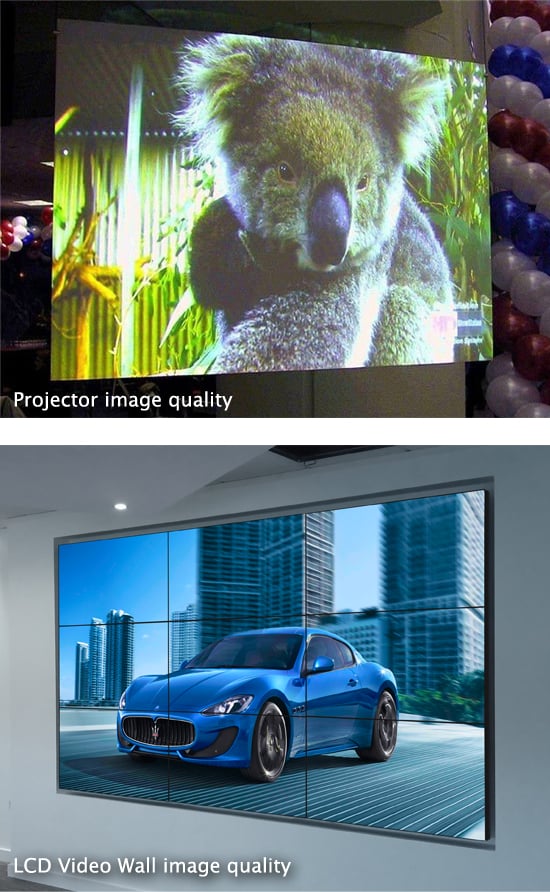
Why chose an LCD Video Wall over a projector for your large display Digital Signage project?
There is a common misconception within the Digital Signage market that projector systems are the most suitable solution for large display projects; this couldn’t be further the truth.
LCD Video Walls have a myriad of advantages over projectors however it is only in recent years that Video Wall solutions have become more popular. Much of their increased popularity can be attributed to the ever decreasing cost of LCD panels; as this is the main cost of an LCD Video Wall Display. Now that LCD Video Wall Display are becoming more cost effective and are competing with projectors the differences between the two solutions are becoming more apparent.
Overall Picture Quality – No matter what is being displayed, whether it is still images or moving video, LCD technology undoubtedly produces a better quality output. There is the obvious difference of LCD Video Walls producing much deeper colours when compared with the “washed out” effect that using a projector causes. As well as this LCD technology offers a much greater contrast ratio meaning blacks are darker and whites are lighter when compared with the image output of projectors. True High Definition display is not possible when using a projector.
Suitability for the Location – Using a projector is inevitably going to cause annoying shadows should anyone break the light field in front of the display; this is obviously not the case for LCD Video Walls. Another major factor that notoriously affects projectors is ambient light levels. If the desired location is extremely dark this issue can sometimes be overlooked, however more often than not there is some kind of ambient light. In these situations the display from the projector becomes even more “washed out”. In contrast to this, ambient light levels have a minimal impact on LCD Video Walls as they use rear projection. Logistically projectors require the desired location to have substantially more space than LCD Video Walls. For example it would be practically impossible to fit a projector system in a corridor however an LCD Video Wall can be fitted virtually anywhere.
Cost and Eco-friendliness – Although the initial cost of LCD Video Walls may be slightly more, due to the running costs of projectors, the return on investment is much higher. The biggest factor here is the maintenance costs of projectors is extremely high. Lamps are usually replaced once or twice a year, sometimes more, and can cost in the region of £200 to £3,000. Projector’s light engines also need to be replacing every few years, these can cost between £300 and £3,500. As well as this LCD Video Walls use less energy; making the more environmentally friendly and cheaper to run day-to-day.
Maintenance – Projectors are infamously difficult to repair when compared with LCD screens. LCD Video Wall Displays are built to last and should rarely require any maintenance during the course of their lifetime. In comparison to this projectors always require regular maintenance, even if it is just to replace the lamp every few months or so. The average lifespan of a projector lamp is 2000-4000 hours, compared with the lifespan of a commercial grade LCD panel of 50,000 hours.
It is apparent that LCD Video Walls provide a much more flexible and sustainable solution than projection systems. Now that the LCD Video Wall market is becoming easier to enter, the variety of new and diverse applications is certainly going to grow.

Thomas Fraser-Bacon is the Marketing Director for Allsee Technologies. His background is in Digital Signage and Product Design.


